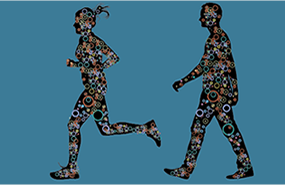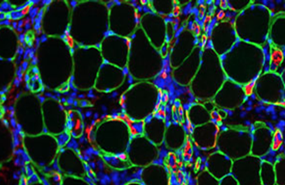 The mission of the Mobility Division is to focus on challenges to physical movement across the life span. The goals of the Division are first, to address fundamental issues by supporting research in areas ranging from biology to the design of the built environment and second, to help translate the fruits of that research into products and policies that sustain or enhance mobility or develop accommodations for those individuals with limited mobility.
The mission of the Mobility Division is to focus on challenges to physical movement across the life span. The goals of the Division are first, to address fundamental issues by supporting research in areas ranging from biology to the design of the built environment and second, to help translate the fruits of that research into products and policies that sustain or enhance mobility or develop accommodations for those individuals with limited mobility.
2014-15 PROJECTS
Fitness Across the Life Span – Collaboration with the President’s Council on Fitness, Sports, and Nutrition
 In July 2014, the President’s Council on Fitness, Sports and Nutrition (PCFSN) signed a Memorandum of Understanding (MOU) with the Stanford Center on Longevity (SCL) to work together to “identify strategies to advance awareness and promotion of physical activity, fitness, and nutrition throughout the entire life span, but especially targeted to helping individuals of all abilities at age 50 and above.” The launch conference held on June 22-23, 2015 marked the start of this exciting collaboration. The conference explored new ways to motivate physical activity in adult Americans. Representative of the need to work across disciplines, the program was led by three Stanford experts representing psychology, technology, and medicine: Dr. Alia Crum (Psychology), Dr. James Landay (Computer Science), and Dr. Michael McConnell (Medicine). Bank of America Merrill Lynch funded the conference. The conferees discussed the convergence of new science on the benefits of all activity (not just vigorous exercise), the proliferation of low-cost wearable sensors, and emerging knowledge about motivation across the life span provides a unique opportunity to create new solutions. Several projects ideas were generated and the Center has moved forward on progressing the state of tracking activity over a full of a 24 hour cycle.
In July 2014, the President’s Council on Fitness, Sports and Nutrition (PCFSN) signed a Memorandum of Understanding (MOU) with the Stanford Center on Longevity (SCL) to work together to “identify strategies to advance awareness and promotion of physical activity, fitness, and nutrition throughout the entire life span, but especially targeted to helping individuals of all abilities at age 50 and above.” The launch conference held on June 22-23, 2015 marked the start of this exciting collaboration. The conference explored new ways to motivate physical activity in adult Americans. Representative of the need to work across disciplines, the program was led by three Stanford experts representing psychology, technology, and medicine: Dr. Alia Crum (Psychology), Dr. James Landay (Computer Science), and Dr. Michael McConnell (Medicine). Bank of America Merrill Lynch funded the conference. The conferees discussed the convergence of new science on the benefits of all activity (not just vigorous exercise), the proliferation of low-cost wearable sensors, and emerging knowledge about motivation across the life span provides a unique opportunity to create new solutions. Several projects ideas were generated and the Center has moved forward on progressing the state of tracking activity over a full of a 24 hour cycle.
Second Annual Design Challenge
 The second Stanford Center on Longevity Design Challenge came to a successful conclusion with the Finals event held on April 9th, 2014. The challenge was titled “Enabling Physical Mobility Across the Life Span” and was open to any university in the world. We asked for solutions to:
The second Stanford Center on Longevity Design Challenge came to a successful conclusion with the Finals event held on April 9th, 2014. The challenge was titled “Enabling Physical Mobility Across the Life Span” and was open to any university in the world. We asked for solutions to:
• Reduce sedentary lifestyles • Encourage and enable physical movement and exercise • Reduce barriers to mobility in the home and community
Eight teams were selected as finalists by a panel of 34 expert judges. The finalist teams represented a broad range, both in geographic terms and in how they approached the topic. Teams from Israel, Italy, and Singapore joined five teams from across the U.S. at the finals (see a full listing of the finalists). The keynote talk at the Finals was given by Professor James Landay from Stanford Computer Science and the afternoon was highlighted by a panel discussion on “Designing for Scale” and included participants from Airbnb, LG Electronics, Orange Healthcare, and Target. The “SPAN” team from the California College of the Arts in Oakland took the top prize of $10,000 with its design of a device that helps older people get up off of the ground safely. Their research indicated that older adults refrain from activities like gardening, yoga, and enjoying time on the ground with children because they are afraid that they can’t stand back up easily. The SPAN device folds into an umbrella-like package, but then unfolds to become a tripod specifically designed for the way experts recommend standing up. The team designed the device specifically for the Stanford challenge and is now looking into commercialization. Second prize was awarded to the Handlebar team from the University of California Berkeley for its design of a device to aid in stair climbing. Third prize went to Luna Lights from Northwestern for a design of a system to automatically light the floor for nighttime trips from bed. A special “Stanford Longevity Technology Prize, in collaboration with Qualcomm and the World Economic Forum’s Global Agenda Council on Artificial Intelligence” was awarded to the “Flipod” team from the National University of Singapore for its design of a device that allows bedridden people to turn themselves and avoid bedsores without needing caregiver help. This team received $5,000 and was given the opportunity to present at the WEF’s Annual Meeting of the New Champions in Dalian, China in September 2015. On the day following the finals, the teams attended a full-day workshop conducted jointly by SCL and the Center for Entrepreneurial Studies from the Graduate School of Business on the topic of “what to do next” with the designs. The teams learned about designing a business plan, legal issues, funding approaches, and the pros and cons of joining incubators and accelerators. Eatwell, last year’s winner, concluded a successful crowdfunding campaign in December, 2014 to fund tooling and shipped its first product in December, 2015. More details
Study on Technology and the “Oldest Old” – a Collaboration with Brookdale Senior Living
 The “Rewiring Aging” survey, conducted by leading global insights firm Kelton in collaboration with the Center and Brookdale Senior Living, suggests that social technology is linked to better wellbeing in adults aged 80 or older. This new finding is a cause for concern for “virtual shut-ins,” or those who do not have any access to the digital world and thus experience loneliness and isolation. The Center on Longevity provided guidance for the structure of the survey as well as analysis of its results. Read more
The “Rewiring Aging” survey, conducted by leading global insights firm Kelton in collaboration with the Center and Brookdale Senior Living, suggests that social technology is linked to better wellbeing in adults aged 80 or older. This new finding is a cause for concern for “virtual shut-ins,” or those who do not have any access to the digital world and thus experience loneliness and isolation. The Center on Longevity provided guidance for the structure of the survey as well as analysis of its results. Read more
News from the Rando Laboratory
 The Center is investigating basic muscle biology through the work of The Rando Laboratory. The lab is directed by Dr. Thomas Rando, the Deputy Director of the Center on Longevity. The main areas of research for the Rando Lab are muscle stem cell biology, muscle stem cell aging, muscular dystrophies, tissue engineering, and basic muscle cell biology. Read more about research at the Rando Lab. In 2015, the Rando lab continued to receive strong support for its work, including renewal of a National Institutes on Aging MERIT award and a Department of Defense grant to study stem cell therapies for muscle injuries and muscle disorders.
The Center is investigating basic muscle biology through the work of The Rando Laboratory. The lab is directed by Dr. Thomas Rando, the Deputy Director of the Center on Longevity. The main areas of research for the Rando Lab are muscle stem cell biology, muscle stem cell aging, muscular dystrophies, tissue engineering, and basic muscle cell biology. Read more about research at the Rando Lab. In 2015, the Rando lab continued to receive strong support for its work, including renewal of a National Institutes on Aging MERIT award and a Department of Defense grant to study stem cell therapies for muscle injuries and muscle disorders.